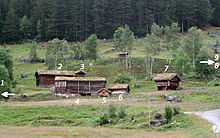Rygnestadtunet


Rygnestadtunet is a farmyard museum at Nordigard, Nørdre Rygnestad in the municipality of Valle in the Setesdal region of Aust-Agder, Norway. It's located near the junction between highways 9 and 45. The farm museum today looks exactly as it did when it was deserted in 1919 and preserved in 1923. It was opened as a museum in 1940. Excavations in the area indicate that the site has been populated since at least 900 AD.
Rygnestadtunet is an authentic farmyard consisting of a brook mill (1), farmhouse (2), storehouse ("loft") built in three stories (3), barn and stable (4), sheephouse (5), barn (6), storehouse on pillars ("loft") (7), blacksmiths workshop (8), and sauna (9). (See the picture to the right for view of each building.) The custom of building a separate house for each purpose was common in the Setesdal valley until the beginning of the World War II. The museum farmyard is only including the old farmyard. The new Nordigard Rygnestad farmyard is situated just below the old one.
Buildings
Rygnestadloftet
The most noted of the buildings is Rygnestadloftet, a storehouse on pillars, built in two stories by Vonde-Åsmund (Åsmund the Evil) (1540-1596) in 1590. Rygnestadloftet is highly valued for its fine proportions, its good craftmaship and use of exquisite materials. The cog joint timber has considerable dimensions. The with of one timber log is enough for the height of the entrance door.
According to the tradition, Rygnestaloftet was also designed for defense, and has served its purpose by some occasions. In the ground floor there is a little shutter covering an opening leading to an escape tunnel ending in a grove some twenty yards above. The ground floor was used for storing food supplies. There is also a bed. The second floor was used for clothes, textiles and valuables. It had an external gallery. On the rear there was built an annex for a so-called "secret", an outhouse, ending on the open ground below. In Setesdal no other example is known of a similar construction.
Farmhouse

The farmhouse, or "stoga" (local expression), has left of to the entrance an authentic open heart house, "gammelstog" (local expression), complete with original fitting out. The timber logs dates from before the black plague 1349-1350 or possibly from the 13th century. To the right of the entrance is the "nystog". It was rebuilt and fitted with fireplace and chimney. The chimey made it possible to build another storey on top. In the front of the building there originally was an external gallery. To make the ridge roof on a level and make it possible to use of the room of the staircase, the headroom in "gammelstog" was extended accordingly. "Nystog" was used for everyday life and lighter cooking, while "gammelstog" served as scullery. Both rooms were used for sleeping.
Old loft
"Trihågloptet" is a unique construction. Its name is a local expression meaning "the storehouse in three stories". As the name indicates it is erected in three stories. Storehouses on pillars was anyway, without exception, built in two stories. "Trihågloptet" was built from the top and downwards. The upper, the cog jointed part—the third storey—was built on cantilevered logs protruding from the second storey in the farmhouse. Later on, presumably after a short time, the two lower storeys were added—not in cog jointed logs—but built in a lighter construction. On the ground floor it had beds connected to the wall, but was otherwise it was used as a storage for food and clothes.
Other buildings
The other farmbuildings, as the little water mill, barn and stable, sheepshed, cowshed, are built principally in the 19th century. The cowshed and the sheepshed is located close to the fodder outlet on the left side of the barn. Just after the turn of the century, the buildings were undergoing a modernization. Another storey was added to the barn and the stable was included in the building. Earlier the stable had been a separate building under its own roof. Traces from the old ways of operation are clearly visible in the buildings.
Buildings like the blacksmiths workshop and sauna was located at some distance from the other buildings due to the inherent risk of catch a spreading fire. The sauna was also used for drying grain and smoking of meat.
Recycling of older building parts
Both in the farmhouse and the storehouse it has been found building parts assumed descending from Nomeland stave church which was demolished about the same time as the farhouse was being built.
References
- Rygnestadtunet, information flyer from Setesdalsmuset.
External links
Coordinates: 59°15′39″N 7°29′11″E / 59.2608°N 7.4863°E